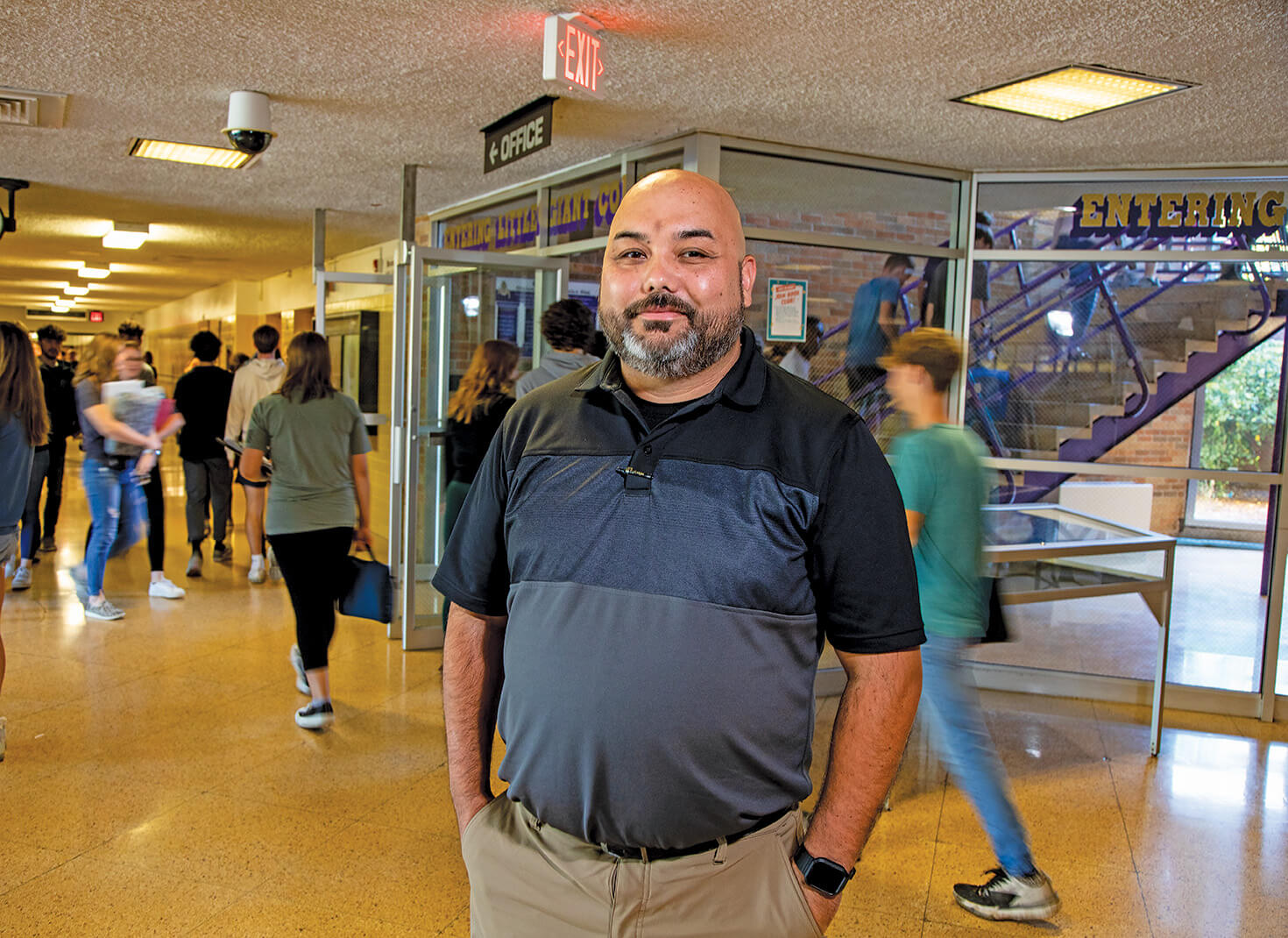Jack Camp, 40, of Peoria, Ill., has faced higher barriers to education and employment than most. For one thing, he served more than 10 years in state prison for armed robbery.
“I grew up a bit rough,” Camp said, significantly understating the case. He was raised in poverty by parents who were both addicted to crack cocaine. His mother (now 23 years clean, he proudly reports) shuttled in and out of prison, and his father was stabbed to death when Camp was just 13. “I struggle with that still,” he said. His parents’ troubles kept the family constantly on the move, and Camp racked up absences as he attended many different schools. In the 11th grade, he dropped out.
“I had a real problem staying focused, dealing with all that adversity and not having a stable place to live, and I made some bad decisions along the way,” he admitted. He did time at the Illinois River and Shawnee correctional facilities and at Pittsfield Work Camp, where he was granted limited freedom to perform outdoor tasks. All the while, he was earning his GED and even some college credits. “I read thousands of books,” he recalled. “I didn’t want to close off my mind.”
Upon release, Camp worked in a warehouse as a janitor and as a painter. He didn’t mind those jobs, he says, but then a friend told him about a program at Illinois Central College where he could earn a commercial driver’s license in six weeks—for free. “I had always liked to drive,” he said, “so I took the initiative.”

Camp is among the many beneficiaries of the Illinois Workforce Equity Initiative (WEI). The program provides state funding for at-risk individuals to enroll in short-term certificate and degree programs in high-demand industries—where jobs typically pay 30 percent above the living wage. In addition to full tuition, students get help with transportation, child care, and other life issues that can stymie educational success.
Illinois, like much of the nation, has enjoyed low unemployment in recent years. Even after the pandemic (and because of labor shortages it created), the state’s jobless rate has hovered near 4.5 percent. But not everyone has benefited from the plenty. Young men of color, in particular, have been left behind. In September 2022, the statewide unemployment rate for Black residents was 11.1 percent.
Educational attainment for this demographic lags as well. Of the associate degrees and certificates that Illinois community colleges awarded in 2019, more than a third were awarded to students of color. Overall, that was an increase in completions among Black and brown students, but 2 percent fewer Black students finished than did the year before. And while 37 percent of those completers were students in career and technical education programs, only 12 percent were African American.
It was this picture that prompted state Rep. Jehan Gordon-Booth, a Democrat who represents Peoria, to launch the initiative. Participants in WEI can select from more than 100 training programs, including in health care, transportation, computer technology, construction, and education. Demand for the programs is high: Many more apply than the program can accept. And of the more than 5,221 students enrolled, 74 percent are Black.

A number of Illinois colleges have embraced the program, and a few have been engaged since its inception. One of them is Illinois Central, a two-year institution in Peoria serving nearly 8,300 students.
Peoria, population 113,000, sits in a fertile agricultural region on the banks of the Illinois River. For decades a chief driver of the city’s economy has been manufacturing—of heavy machinery, farm implements, and other products. Until recently, Peoria served as the headquarters for Caterpillar Inc. Although the heavy-machinery giant dealt the city a blow in 2017 when it moved to suburban Chicago (and recently announced a move to Texas), its factories still employ 12,000 people here. Other area employers are Komatsu, another manufacturer of heavy equipment; and Morton Industries, a manufacturer of metal products.
A changing local economy
But the region’s economy is diversifying. In the 1990s, the manufacturing sector employed one in every four Peorians; today it employs just one in eight. Other large employers are in health care, education, and logistics.
One problem with Peoria’s employment picture—and perhaps one reason that the city’s economic growth rate is expected to lag the nation’s—is the mismatch between the skills of Peoria’s workforce and those needed for available jobs. (Among Caterpillar’s top reasons for leaving Illinois and moving to Texas, a spokesman told the media at the time, was “access to talent.”)
In particular, Peoria’s Black residents, who make up 28 percent of the population, have felt the effects of institutional racism on the kind of education that brings those employment opportunities. Whereas 40 percent of white men in Peoria have a college degree, just 11 percent of Black men do. One in five Black men in Peoria (22 percent) lack even a high school diploma; the figure for white men is just 7.7 percent. One of five Peoria residents also live in poverty.
For these individuals, there are multiple barriers to returning to school, not least of which is the bad experience they had with school in the first place. “These are issues that start in the ninth and tenth grade, and that leads to dropping out,” said Jason Juchems, an area high school administrator who, until this July, served as workforce development manager at Illinois Central. “They don’t have warm and fuzzy feelings about school.”
In his role at Illinois Central, it was Juchems’ job to prepare WEI students for college-level work. And for many of them, that meant re-teaching material normally presented in eighth grade.
Students’ proficiency levels in reading and math run the gamut, Juchems said, starting as low as fifth grade. But WEI seeks to aid students 18 and over who are performing at the level of middle school. The goal is to get them up to 11th- or 12th-grade level in eight weeks, with students attending full time.
Participants generally take basic math courses related to their future jobs; students planning careers in construction, for instance, would learn (or re-learn) some basic geometry. Reading comprehension among these students also usually needs a boost, and courses in computer literacy are essential. All are taught in ways that also develop students’ social and emotional well-being.
“We can have behavioral outbursts just like in K-8,” Juchems said. So counselors also help students learn how to regulate their emotions, study effectively, and manage their time and money. Many students also need help working in teams, he said.

Jack Camp participated in the WEI readiness program six hours a day for eight weeks and was paid an hourly stipend for attendance and completion. He picked up basic computer skills, brushed up on his writing, and learned how to draft a professional resumé. Representatives from various industries exposed him to careers and conducted mock job interviews. “The program was great,” Camp said. “I didn’t waste the opportunity. I never missed a day or was late. I never gave excuses about anything.”
With the basics under his belt, he enrolled in a CDL program at the college, with the WEI grant paying for his tuition and supportive services. “It was $3,500 or $4,000, and that was more than I could afford,” he said. In this segment, much of which was hands-on, he learned about air-braking, shifting, turning, coupling, logbook-keeping, safety, and inspection. “They had trucks right outside that you could learn on,” he said. “I’m not saying it was easy. Pulling up to the loading dock was the hardest.”

Although he is now qualified to drive them, and did so for a brief time, Camp quickly decided that semitrailers were not for him. “You know how you feel when you are going down the highway and these big 18-wheelers are all around you? Well, I felt that way, too, and I was driving one.” Camp is now content to be working a solid 40 hours a week driving a box truck—local routes only— for Metro Moving and Delivery Service in East Peoria.
More help on the way
Now in its third year, with 17 two-year colleges participating, the WEI program has produced promising results. But as the initiative continues, it has become increasingly apparent that the people it seeks to help face even more challenges than most. Of those 5,221 students enrolled, only half have earned credentials so far. This doesn’t mean the other half won’t finish; many students are still enrolled, and in 2020 and 2021, COVID-19 disruptions hit the program’s target population particularly hard.
Still, the completion rates suggest that participants may need even more intensive services or require more tailored approaches.
Toward that end, the Illinois Community College Board has launched a plan to bring students even greater support and stronger links to employers. Through its new Employment Connection Project, the board and its colleges are working to better identify and engage employers to more reliably connect students to good jobs.
To do this, the program is making the most of existing partnerships, such as its alliances with the Illinois Manufacturing Association, the Technology Manufacturing Association and American Job Centers. And colleges will now assign each student an employment “navigator”—a counselor to connect students with local jobs. These counselors will work directly with employers and ensure that students have the essential skills to make a successful transition to the workforce.
Camp’s transition was certainly smooth. In fact, he’s likely to be fully employed as a truck driver as long as he wants to be. The American Trucking Associations reported a shortage of 80,000 drivers last year, an all-time high that could reach 160,000 by 2030. The organization wants to recruit a million new drivers over the next decade.
And Camp has no doubt about what secured his future. “WEI changed my life,” he said.
